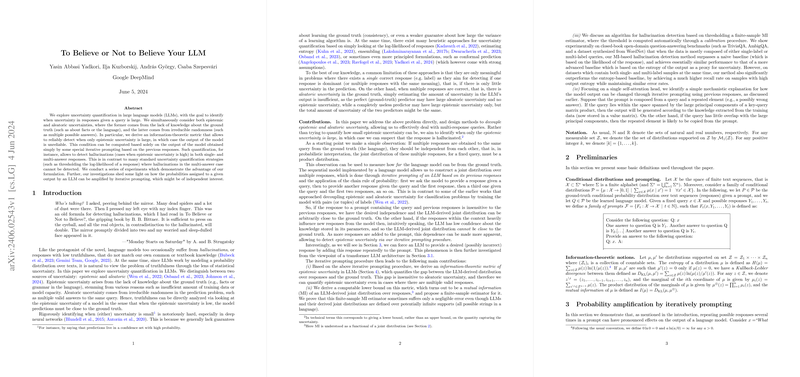An Exploration of Uncertainty Quantification in LLMs
The paper "To Believe or Not to Believe Your LLM" by Yasin Abbasi Yadkori, Ilja Kuzborskij, Andr as György, and Csaba Szepesv ari from Google DeepMind addresses the critical issue of uncertainty quantification in LLMs. This research bifurcates uncertainty into epistemic and aleatoric types and proposes a novel method to measure these uncertainties to identify unreliable model outputs.
Overview and Core Contributions
The authors focus on differentiating between epistemic uncertainty, which arises from a lack of knowledge about the ground truth, and aleatoric uncertainty, which stems from inherent randomness in the problem domain. They offer an information-theoretic metric to reliably detect high epistemic uncertainty, signaling when the model's output is likely to be unreliable. The key contributions are threefold:
- Information-Theoretic Metric for Epistemic Uncertainty:
- The authors define a metric that quantifies the epistemic uncertainty based on the gap between the LLM-derived distribution over responses and the ground truth. This metric is designed to be insensitive to aleatoric uncertainty.
- Iterative Prompting Procedure:
- A novel iterative prompting procedure is introduced to construct a joint distribution over multiple responses. This method enhances the ability to detect epistemic uncertainty by focusing on the dependencies revealed through sequential responses to the same prompt.
- Experimental Validation:
- The research demonstrates the efficacy of their method through a series of experiments on closed-book open-domain question-answering tasks. Their proposed algorithm outperforms baseline methods in both single-label and mixed-label settings.
Numerical Results and Experimental Insights
The authors conduct extensive experiments using randomly selected subsets of the TriviaQA and AmbigQA datasets, along with a newly synthesized WordNet dataset designed to contain truly multi-label queries. The key results are:
- Precision-Recall (PR) Analysis:
- On predominantly single-label datasets like TriviaQA and AmbigQA, the proposed Mutual Information (MI)-based method shows similar performance to the semantic-entropy (S.E.) baseline but significantly outperforms simpler metrics like the probability of the greedy response (T0) and self-verification (S.V.) methods.
- For mixed datasets combining single-label and multi-label queries (TriviaQA+WordNet and AmbigQA+WordNet), the MI-based method shows superior performance, especially on high-entropy multi-label queries, where the S.E. method's performance degrades noticeably.
- Robustness to High-Entropy Queries:
- The MI-based method demonstrates higher recall rates on high-entropy queries, indicating its robustness in detecting hallucinations amidst significant aleatoric uncertainty. This advantage is particularly evident in scenarios where mixed datasets are employed, reinforcing the method's effectiveness in diverse query settings.
Theoretical and Practical Implications
The authors map out the theoretical underpinnings of their MI-based metric, establishing a lower bound on epistemic uncertainty. This is complemented by rigorous proofs and algorithmic formulations for practical estimation. The implications of this work are twofold:
- Theoretical Impact:
- The proposed method advances our understanding of how epistemic and aleatoric uncertainties can be decoupled in LLM outputs. This decoupling is crucial for improving model reliability and trustworthiness, particularly in applications where the cost of incorrect or hallucinated responses is high.
- Practical Applicability:
- The iterative prompting procedure is a lightweight yet powerful tool that can be integrated into existing LLM inference pipelines without requiring substantial modifications to the training process. This makes the solution highly applicable and scalable across various real-world scenarios where LLMs are deployed.
Future Directions
Moving forward, research could explore several extensions and refinements:
- Adaptation to Different Model Architectures: Assessing how the proposed methods perform across different LLM architectures and sizes could yield insights into scalability and generalizability.
- Dynamic Threshold Adjustment: Automating the threshold calibration for abstention policies in real-time based on ongoing feedback and usage patterns could enhance the method's utility in dynamic environments.
- Broader Dataset Evaluation: Further validation on a more extensive range of datasets, including those with diverse domains and query formats, would strengthen the generalizability claims of the proposed metric.
Conclusion
In summary, the paper presents a robust approach to uncertainty quantification in LLMs, providing clear advantages in identifying unreliable outputs. By decoupling epistemic and aleatoric uncertainties, the method enhances model reliability, making it a valuable contribution to the field of AI and natural language processing. The precise mathematical formulations, combined with practical algorithmic implementations, pave the way for more reliable and trustworthy LLMs.
